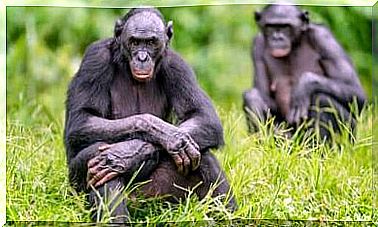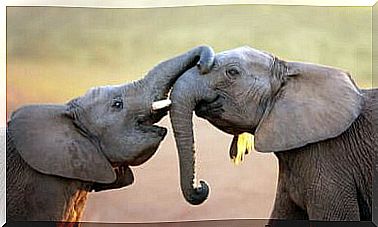What Are Primates? Let’s Discover The Cousins of Man
The primates are an order of mammals to which they belong humans and other great apes. It is a very diverse group, in which it is possible to find both a 30 gram mouse lemur and a 200 kg adult gorilla. This order of animals is characterized, among other things, by having five fingers on the hands and feet, binocular vision in color and nails instead of claws, with opposable thumbs.
Unfortunately, it is also a very threatened order. Do you think that 60% of primates could disappear in the next 25 years, due to the selfishness of mankind.
The primates of the wet nose
The primates furthest away from us, on the evolutionary scale, are the strepsirrins, whose name means “curved nose”. This fact is due to the fact that they have wet noses (rinario), because in this way they better protect their sense of smell, one of their most important senses.
The more than 100 species of lemurs that populate Madagascar belong to this group , animals characterized by very characteristic vocalizations and surprising olfactory communication. Among them is the famous and distinctive Ring-tailed Lemur .
Many nocturnal animals, such as lorysids and galagids, are also included among the strepsirrhines. Unfortunately, these groups of primates are dangerously threatened by the illegal trafficking of exotic animals.
The simple-nosed primates
The rest of the primates are known as haplorrhini , that is “simple-nosed”, because in this case the rhinarium (or truffle) is not developed, which allows the appearance, in many of these primates, of recognizable faces and with a accentuated facial expression.
Within this group are the tarsiers, characterized by large eyes, elongated feet and small body. Their habitat is limited to Indonesia, where they are considered demonic animals.
Leaving the tarsiers in their particular primate family, the rest of the haplorrhini are the simiiformes, and are divided into “old” and “new” world monkeys.
New world monkeys
All primates of this group live in Central and South America. It is in this group of monkeys that we will find those with prehensile tails. This means that many of them can use their tails as a fifth limb.
The prehensile tail not only allows these primates to hang from tree branches, but can also be used to pick up objects and scratch themselves. As you can see, the tail has great sensitivity, functioning as a real hand, a kind of extra arm. An example of this ability is particularly evident in the examples of capuchin monkeys.
This group of primates mainly feeds on fruits and has a flattened snout with lateral nostrils. They are primates closely related to trees and heavily affected by deforestation.
In this group we find marmosets, tamarins and lion monkeys, which are some of the smallest primates.
The pygmy marmoset weighs just over 100 grams. In addition to them, howler monkeys ( aotus ), nocturnal monkeys ( alouatta caraya ) and spider monkeys ( atele ) are also worth mentioning .
Old world monkeys
These primates that inhabit Africa and Asia are also called catarrhini , which means “narrow nose”. These living beings lack prehensile tails and usually have calluses on the buttocks. The majority of these monkeys belong to a larger group called cercopithecuses, and have among their ranks very interesting specimens, such as baboons, macaques, colobus and vervet monkeys.
The largest of all is the mandrill, which can reach 50 kg in weight. However, there are also small vervets, such as the dwarf vervet, which barely reach the kilo.
Hominoids
We have arrived at the group of tailless primates, where we find the gibbon. It is a very special primate that moves by exploiting brachiation, that is to say its ability to use its arms and legs to move, swinging, between the branches of trees.
The rest of the hominoids are the so-called great apes. The Homo sapiens species belonging to mankind is included in this group. Here, we find ourselves next to gorillas, chimpanzees, bonobos and orangutans.
Most of them are found in Africa and, in fact, gorillas, chimpanzees and bonobos can share the same habitat , although this is becoming less and less frequent. Bonobos and chimpanzees are very similar physically, but have radically different cultures.
This group is characterized by having the highest cognitive abilities compared to all other primates. There are members of many of these species who have been able to communicate with humans through sign language and behave in a similar way to us when it comes to the burial of the dead.
Unfortunately, it is also a very threatened order. According to the latest data, it is possible that 60% of primates may disappear before the next 25 years. It is sad and grotesque, at the same time, that the “less” evolved primates end up being exterminated by the theoretically “more” intelligent one.









